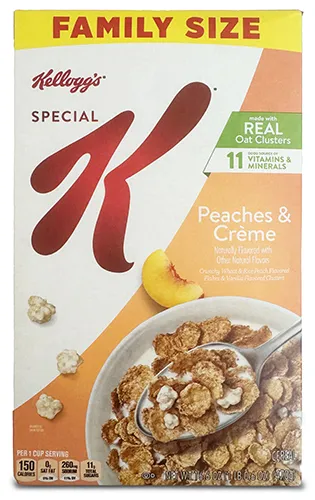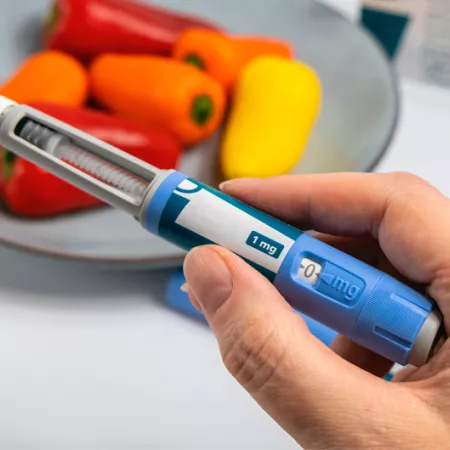Food marketing: These 9 foods look healthier than they are

Pisahouse - stock.adobe.com.
Food marketing is like magic. It can turn processed cereals into fonts of fiber, sugary drinks into fruit, and plastic bottles of water into hydration products. Here are 9 examples. All capitalize on at least one strategy from the food marketers’ playbook to look healthier than they are.
This article comes from Nutrition Action. We don’t accept any paid advertising or corporate or government donations. Any products we recommend have been vetted by our staff and are not advertisements by the manufacturers. They’re just healthier foods we think you’d like to know about!
1. Food marketing strategy: Get a Greek-yogurt health halo

Clio Yogurt Dipped Strawberry Banana Mini Greek Yogurt Bars have some yogurt, but it’s mixed with cane sugar (5 grams) and saturated palm kernel oil, plus about a dozen other ingredients like dry milk, whey protein, tapioca dextrin, yogurt powder, xanthan gum, and soy lecithin.
If you’re looking for yogurt, you can do better. Much better.
Each 70-calorie mini Clio bar has just 3 grams of protein and 33 milligrams of calcium. That’s far less than you’d get from the real deal: A 70-calorie serving of plain Fage 2% (low-fat) Greek Yogurt has three to four times as much protein (10 grams) and calcium (120 mg).
Of course, the itty-bitty Clio bar would deliver more protein and calcium—along with more sugar and calories—if it were bigger. Each mini Clio is about the same size and has about the same number of calories as a fun-size Snickers bar. In fact, Clio got its start as a chocolate-covered yogurt bar maker before releasing the “yogurt dipped” bars.
Why the switch? Replacing the chocolate coating with plain yogurt in strawberry banana or mixed berry flavors “placated consumers who don’t view chocolate as a fit for breakfast,” noted a FoodDive.com article that interviewed Clio’s CEO, “while helping Clio grow morning snacking occasions and opening up a larger market for kids and people who don’t like chocolate.”
Translation: A yogurt coating can sell snack bars.
Bottom line: Whether it’s dipped in yogurt or chocolate, a processed not-much-yogurt bar isn’t a healthy breakfast or a “morning snacking” staple. Instead, think of mini Clios as portion-controlled desserts. (The company even touts the bars’ texture as cheesecake-like.)
2. Food marketing strategy: Sprinkle in some high-value nuts

What’s the main ingredient in Walmart’s store-brand Bettergoods White Hazelnut Spread, with its “perfect balance of roasted hazelnut and rich milky taste”? Hazelnuts? Nope. Milk? Try again.
The spread has more sugar and vegetable oils (canola and sunflower)—the first two ingredients—than skim milk powder or hazelnuts. Then come cocoa butter, whey powder, lecithin, and natural flavor.
That explains why each two-tablespoon serving delivers 15 grams of added sugar. That’s only 1 gram less than you’d get in 2 tablespoons of Duncan Hines Whipped Fluffy White Frosting, though the frosting has fewer calories (110 vs. 200).
And speaking of marketing-speak, we asked Walmart what the label means when it says “crafted artisanally.” Is the spread manufactured by small-scale artisans? Or do they even make any of its eight ingredients? By our deadline, we hadn’t heard back.
Bottom line: Nuts are healthy, but if a product calls itself a nut “spread,” check the Nutrition Facts and ingredients. “Spread” can be code for “more sugar and oil than nuts.” (Nutella has cashed in on that ploy for years.) In contrast, “peanut butter” must be at least 90 percent peanuts and typically has just 0 to 2 grams of added sugar per serving.
3. Food marketing strategy: Add protein. Subtract seed oils

“Khloud Protein Popcorn, the better-for-you snack brand founded by Khloé Kardashian, is a breakout success in the salty snack category,” trumpeted the company’s June press release. “Khloud was created in response to the increased consumer demand for convenient protein sources, debuting with a popcorn offering triple the protein of other popcorn brands.”
“Triple the protein” sounds good, but popcorn doesn’t have much to start with: just 2 grams in a 1 oz. serving. So Khloud Kettle Corn’s 7 grams doesn’t hold a candle to low-fat Greek yogurt or cottage cheese, which supplies two or three times that much protein for the same calories as Khloud (150). And plenty of other convenient snacks—like string cheese, a hard-boiled egg, or 1 oz. of peanuts, pumpkin seeds, or crispy chickpeas—have a similar 6 or 7 grams of protein per serving.
So there’s no need to sprinkle popcorn with milk protein isolate (aka “Khloud dust”), unless you’re trying to sell more popcorn…or more pretzels, chips, cookies, or other protein-pumped snacks.
And you can ignore the “no unhealthy seed oils” promise on the bag of Khloud Sweet and Salty Kettle Corn Protein Popcorn. Why? Because seed oils aren’t unhealthy. And Khloud makes things worse by replacing them with healthy olive oil plus unhealthy coconut oil. Your arteries can blame the coconut oil for the kettle corn’s 4 grams of saturated fat (20 percent of a day’s max) per serving.
Bottom line: Most U.S. adults eat far more protein than they need. But if you’re trying to get more, snack on healthy foods like nuts, seeds, beans, and low-fat dairy, not protein-dusted packaged snacks.
4. Food marketing strategy: Add fruit flavor, not fruit

The front of the Special K Peaches & Crème Cereal box features a slice of juicy peach, but there’s not even a sprinkle of dried peaches (or any fruit) in the ingredients list. What gives? The smaller print under the large “Peaches & Crème” notes that the cereal is “naturally flavored” and contains “crunchy wheat & rice peach flavored flakes.” But who can blame Kellogg. The FDA’s labeling rules allow pictures of fruit even if a food only contains the fruit’s flavor. And hey, Peach Flavored Wheat & Rice Flakes & Crème probably wouldn’t sell as well. (We’ve seen this movie before from Kellogg.)
What about the “made with REAL oat clusters” on the box? The cereal has more refined rice and added sugar than oats. Repeat after us: “made with” can mean “made with very little.”
“Special K is focused on bringing you real ingredients,” says the box. Hmm…maybe start with some real peaches? Or more real oats?
Bottom line: Many Special K cereals have more added sugar than the healthiest cereals and dress up their boxes with whatever sells. You can do better.
5. Food marketing strategy: ‘Hydration’ sells

“Perfectly balanced water,” says the bottle. “CORE Hydration mirrors your body’s natural pH balance of about 7.4 pH. CORE Hydration is purified in a seven stage process. Electrolytes and minerals are added for taste. CORE Hydration is perfectly balanced and helps you stay hydrated and feeling your best.”
Whew. Whether it’s about pH, electrolytes, or the vague promise of “hydration,” CORE sure can push a plastic bottle of water:
“pH balance.” A neutral pH—around 7 on the 0-to-14 pH scale—is nothing out of the ordinary. You’d expect the pH of drinking water (which you can get for free from the tap) to be similar. In fact, the only drinking water that typically falls far outside of the neutral pH zone is gimmicky “alkaline water,” which some companies bottle and sell at a premium for its 8-to-9 pH. But there’s no need to buy bottled water that touts a specific pH range—whether it’s 7, 8, or 9. Our bodies keep our blood’s pH within a tight range, regardless of what we eat or drink or how acidic or alkaline those foods and beverages are. So don’t sweat it.
“Electrolytes.” CORE notes that its electrolytes “are added for taste.” Translation: Don’t expect much. CORE adds zero sodium, a key electrolyte in sports drinks and Pedialyte. And it adds other electrolyte minerals at levels so low that the Nutrition Facts label doesn’t have to disclose the amount.
Of course, for many of us, getting more electrolytes doesn’t even matter. Unless you’re doing prolonged, sweaty exercise, all you need is plain water plus the electrolytes that are naturally present in the food you eat.
Bottom line: Any water “helps you stay hydrated and feeling your best.”
6. Food marketing strategy: Bring your own strength training

Pop quiz: What makes an Atkins Strong Chocolate Chip Cookie Dough High Protein Bar (“helps maintain muscle”) different from any other food with 20 grams of protein?
Answer: The fine print. The label explains that the bar “helps maintain lean muscle mass when used in conjunction with an exercise routine.” That’s no surprise. The evidence is clear that strength training, not endless amounts of protein, is the key to getting stronger. (Most U.S. adults are already eating more protein than the roughly 50 grams per day that health authorities recommend.)
What’s more, Atkins adds enough palm kernel and palm oils to reach 5 grams of saturated fat (a quarter of a day’s max) per bar. And it sweetens its bars with sucralose, which we rate as “avoid.”
If you’re looking for a mini-meal or snack with at least 20 grams of protein, you can do better. Here are four examples, all with less calories than the 230 in a “Strong” bar:
- Cooked skinless chicken breast (3 oz.) – 26 grams of protein, 140 calories
- Tofu, super-firm (5 oz.) – 22 grams of protein, 200 calories
- Chobani 20g Protein Greek Yogurt (6.7 oz. tub) – 20 grams of protein, 140 calories
- Cottage cheese, low-fat (3/4 cup) – 20 grams of protein, 140 calories
Bottom line: Strength training—not a snack, even a “Strong” one—is your best tool for building or maintaining muscle.
7. Food marketing strategy: Dress up a sugary drink with superfruits

Jamba Over Ice is a line of six drinks that the smoothie chain added to its menu earlier this year.
“Last month, Jamba introduced its first major menu launch since 2019 with an all-new line of OverIce beverages,” said the company’s March press release. “A refreshing iced beverage, made from a blend of fruit juices and topped with fruit puree or fresh fruits that pairs perfectly with a bowl or bite for a quick meal or snack!”
Let’s look at two examples:
Mangomorphosis. It “comes with the tangy flavors of passion fruit & mango and a zest of lemonade and layered with a delicious housemade dragon fruit puree,” said Jamba’s press release. But dragon fruit is the last ingredient. The drink is mostly a mix of reconstituted “passion fruit mango concentrate” (which has more pear and grape juice concentrates than mango, orange, or passion fruit juice concentrates) plus lemonade. Jamba’s website doesn’t disclose how much of the total sugar in a Mangomorphosis (31, 38, or 54 grams in a small, medium, or large) comes from the juices and how much comes from added sugar.
Dragonberry Blitz. Jamba’s release described the flavor of this lemonade-fruit juice blend as “a vibrant blend of real mixed berry juice, infused with a housemade dragon fruit puree and topped with fresh blueberries.” Umm…“real mixed berry juice”? It’s a “mixed berry flavored grape juice blend” with—you know the drill—more grape and pear juice than any of its berry juices. Total sugar ranges from 35 grams (in a small) to 60 grams (in a large).
Do Jamba’s “Over Ice” concoctions sound familiar? Starbucks hit the sugary, fruity drink scene years ago. The coffee shop’s popular Lemonade Refreshers, which come in flavors like Strawberry Açaí and Mango Dragonfruit, are adorned with a spoonful of freeze-dried strawberries or dragon fruit pieces. Total sugar ranges from 24 grams (in a tall) to 65 grams (in a trenta).
Bottom line: Don’t fall for the fruit hype. Skip sugary Starbucks Refreshers and copycats like Jamba Over Ice and Dunkin’ Refreshers. For a healthier yet refreshing iced beverage, try some unsweetened iced tea with citrus or cucumber slices or lightly mashed fresh berries.
8. Food marketing strategy: Pump up the (processed) fiber

“Check out Magic Spoon Protein + Fiber, our new line of cereals available exclusively at Whole Foods Market nationwide!” the cereal company announced on Facebook earlier this year.
The new “High Fiber” version of grain-free Magic Spoon Fruity Protein Cereal that’s sold at Whole Foods has 6 grams of fiber per serving because the company adds “soluble tapioca fiber.” The FDA lets Nutrition Facts labels count that as fiber because studies show that it boosts calcium absorption in the gut. Ditto for other “resistant dextrin” or “resistant maltodextrin” processed fibers. (Only processed fibers with an approved health benefit can count as “fiber” on labels, the FDA’s rules say.)
That’s fine. But if you’re like many people, boosting calcium may not be the benefit you want from your high-fiber cereal. For example, the wheat bran that’s added to bran flakes and that occurs naturally in shredded wheat can help you stay regular. And the soluble oat fiber that occurs naturally in oatmeal or the psyllium fiber that’s added to Kellogg’s All-Bran Buds can help keep a lid on your cholesterol. Because Magic Spoon and many other low-carb, high-protein cereals contain no grains, they can’t match the health benefits of low-sugar cereals that are 100 percent whole grain or rich in bran.
Bottom line: Don’t assume that all “high fiber” cereals come with the same health benefits.
9. Food marketing strategy: Fortify your way to immunity

How does Ocean Spray sell “immunity” in a bottle?
Every 10 oz. Ocean Spray Immuni+y Cranberry Blueberry Acai contains enough added vitamins and minerals to supply 15 percent of a day’s zinc and vitamin E plus 130 percent of a day’s vitamin C.
Here we go again. Fortifying juices, cereals, and other foods with vitamins and minerals that “support immunity” is one of the oldest tricks in the book. As long as marketers don’t name a disease or health condition, they can make claims about how a food or beverage affects the structure or function of the body with little oversight by the FDA.
But unless you’re actually deficient in vitamins C or E or zinc, consuming more of them is unlikely to ward off infections. And if you’re worried that you might be eating less of those nutrients than you should, it’s easy to cover your bases with a multivitamin-and-mineral supplement. Many multis come closer to supplying a day’s worth of zinc and vitamin E—plus other key vitamins and minerals—than a bottle of Immuni+y does.
Maybe vitamin-and-mineral claims help Ocean Spray distract shoppers from noticing that its Cranberry Blueberry Acai juice drink is really grape, blueberry, and cranberry juice plus “natural acai flavor.” That explains why the product’s full name—partly buried in the finer print—is “Ocean Spray Immuni+y Cranberry Blueberry Acai Flavor Flavored Juice Drink with 3 Juices from Concentrate and Other Natural Flavor.” Geez.
Bottom line: Fortified juice is no immune booster. And Ocean Spray Immuni+y Cranberry Blueberry Acai’s 17 grams of sugar from juices may not count as “added” sugar, but they’re liquid calories (80 in the 10 oz. bottle) that are less likely to fill you up than chewing on whole fruit. Skip it.
Support CSPI today
As a nonprofit organization that takes no donations from industry or government, CSPI relies on the support of donors to continue our work in securing a safe, nutritious, and transparent food system. Every donation—no matter how small—helps CSPI continue improving food access, removing harmful additives, strengthening food safety, conducting and reviewing research, and reforming food labeling.
Please support CSPI today, and consider contributing monthly. Thank you.
More on deceptive marketing
5 protein myths: You may be surprised
Fact vs. Fiction

13 foods with more salt, sugar, or fat than you might expect
Healthy Eating

Taking GLP-1 obesity drugs? Here's what to eat or avoid.
Weight and Health

Prevagen ordered to cease ‘memory improvement’ claims
Supplements

April Fools! Watch out for these food label tricks
Fact vs. Fiction


